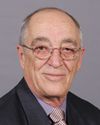Thanks very much.
I'll be making this presentation on behalf of the health portfolio, as you've mentioned. Thank you for inviting us to speak to you today about healthy aging for Canadians, and how the results of our work relate to this committee's review of veterans health care.
You've asked us to focus on the issues from a general seniors population perspective that you can consider in your deliberations on the recommendations of the Gerontological Advisory Council and the report Keeping the Promise. You specifically want us to help you consider the recommendation for increased health promotion and innovative service delivery that would help to better meet the health needs of Canada's military service veterans today and into the future.
My focus today is on the public health role in healthy aging—what it is, how it can be achieved, its benefits to older Canadians, their families and to Canadians in general. I will highlight trends and research that support a health promotion approach to meeting seniors' health needs including veterans, and provide some examples of the many and varied initiatives and research undertaken by the Public Health Agency of Canada and our partners in the federal health portfolio.
Our work clearly confirms the importance of intensifying population-based approaches to promoting healthy aging.
Let me start by telling you about our role. The federal health portfolio, which includes Health Canada, the Public Health Agency of Canada, Canadian Institutes of Health Research, and other organizations, works to help the people of Canada maintain and improve their health. The mission of the Public Health Agency of Canada is to promote and protect the health of Canadians through leadership, partnership, innovation, and action in public health. We work to promote health and prevent disease and injury, and on emergency preparedness and response. Our work also includes laboratory testing and regulation that support action during infectious disease outbreaks and emergencies.
The public health role related to seniors is guided by a focus on healthy aging; that is, a lifelong process of optimizing opportunities for improving and preserving health and physical, social, and mental wellness; independence; quality of life; and enhancing successful life-course transitions.
The broad definition is consistent with and adapted from the World Health Organization's definition of active aging. It also reflects our knowledge that a number of factors interact to influence our physical, mental, social, and spiritual well-being--such factors as income, education, health services, personal health practices, and coping skills to name a few.
This approach encourages us to focus our efforts upstream—that is, before people become ill or injured. At the same time, we need to support those living with chronic disease and disability and help prevent further illness among this vulnerable group which can include veterans.
Let's also set the stage with some facts about seniors, their health and healthy aging. It won't surprise you to hear that as individuals and as a population, Canadians are aging. While today, people aged 65 and over make up some 13% of the Canadian population, by 2041, they will account for 25% of the total population, and they will number some nine million people.
The good news is that older Canadians are living longer and with fewer disabilities than the generations before them.
Almost three quarters of seniors living at home in 2003 rate their overall health as good, very good, or excellent. Nearly one half of seniors say they are physically active. A third report getting a flu shot within the last year—that's as of 2005. Seniors are active in social and economic life in their communities. They are working longer, and when they retire from paid employment they continue to play a vital role in a wide range of community activities—on boards, in schools, and by providing vital support to families and other seniors. Clearly, seniors are taking action to look after their health and well-being.
However, there's more to this picture. We also know that a large majority of seniors—that's 85% of those aged 65 to 79—have at least one chronic disease or condition, such as asthma, arthritis, rheumatism, high blood pressure, emphysema, chronic obstructive pulmonary disease, diabetes, heart disease, cancer, schizophrenia, mood or anxiety disorder, or obesity.
More than one in four have four or more chronic diseases. Prevalence is higher among our most vulnerable seniors--for example, economically disadvantaged groups. Some 15% of Canadians aged 65 and over have been diagnosed with diabetes. In 2007, an estimated 70,000 new cancer cases occurred among Canadians aged 70 years or older.
Disability rates increase with age, from 31% among younger seniors—that's the 65-to-74-years group—to 53% for older Canadians. For these people, everyday activities are limited because of a health condition or problem.
Seniors, especially those over 85, are much more likely to have Alzheimer's disease or related dementia; one in three older seniors is affected. By 2031, we can expect the number of Canadians with dementia to triple from its 1991 level.
Clearly, chronic diseases account for an enormous burden—to individuals, their families and other informal caregivers, to the health care system and to the Canadian economy.
Chronic diseases are responsible for 67% of total direct costs in health care and 60% of total indirect costs ($52 billion) as a result of early death, loss of productivity and foregone income.
Promoting health is therefore something that definitely makes sense. The federal government works closely with provinces and territories to find ways to collaborate in the area of seniors' health.
Our work as co-lead of Canada's working group on healthy aging and seniors' wellness—that's a working group of the federal-provincial-territorial ministers responsible for seniors—resulted in a report called Healthy Aging in Canada: A New Vision, a Vital Investment. This 2006 report brings together our knowledge about seniors' health; research, including what we know and don't know about what contributes to the health and well-being of seniors and what public health interventions play a role; as well as a recommended framework for action.
This and other research tells us that, for example, there is a clear need for and there are clear benefits associated with helping people maintain optimal health and quality of life at every stage of life.
Relative to all other population groups, healthy lifestyle changes have the greatest impact on health status for seniors. For example, later-life introduction of regular physical activity can extend years of life and years of independent living and can improve the quality of life of older people.
Health promotion efforts are important to disease prevention. Up to 70% of cancers, 90% of type 2 diabetes cases, and 50% to 70% of strokes are preventable.
Seniors living at home generally want to avoid entering a long-term care facility. Moreover, home care can be a cost-effective alternative to long-term facility care, and long-term care in the home can reduce or avoid the need for costly acute-care hospitalization.
So by providing the right supports and services at the right time in the right setting, we can better promote and support the health of Canadians as they age, while reducing the burden on the already overwhelmed system.
Let's turn to some of our recent and current work, starting with building the evidence base.
A key aspect of public health is the continual monitoring of trends and emerging issues. We work with partners to collect and analyze data on chronic disease and other health issues, making it available to researchers and decision-makers. Here are some highlights:
Our chronic disease infobase profiles the epidemiology of major non-communicable diseases in Canada, including most current cancers and cardiovascular and respiratory diseases, by province and territory and by regional health unit.
The Canadian integrated public health surveillance service brings together the strategic alliance of public health and information technology professionals, working collaboratively to build an integrated suite of computer and database tools specifically for use by Canadian public health professionals.
The Public Health Agency of Canada and Health Canada have been working with Statistics Canada to develop the Canadian community health survey on healthy aging. This survey will deal with the topic of aging and factors that affect healthy aging such as general health and well-being, use of health care services, social support networks, and work-and-retirement transitions. Data collection will take place for a year, beginning in the summer of 2008.
The Canadian Institutes of Health Research is investing in age-related research to create knowledge in the field of aging and advance the knowledge into action to improve the quality of life and health of older Canadians. In 2006-07 this investment totalled over $85 million. The lead CIHR Institutes in this area are the Institute of Aging and the Institute of Health Services and Research Policy.
We must find new and better ways of chronic care management. While prevention of disease is critical, we must also address the needs of Canadians, including seniors, with chronic disease and to prevent further illness, injury and disability.
One of our current and important initiatives in this area is the Canadian diabetes strategy's national project with the Active Living Coalition for Older Adults, aimed at supporting older adults in leading a healthy-activity lifestyle. Ultimately, our work will result in a comprehensive action plan to address diabetes among older adults.
The Canadian best practices portal for health promotion and chronic disease prevention contains relevant and accessible best practices information to enhance decision-making for practitioners, policy-makers, and researchers. The portal currently provides access to 16 interventions to help seniors prevent and address chronic disease and promote health, related to nutrition, physical activity, smoking cessation, and other issues.
The Public Health Agency of Canada also works with a national network of experts to address the public health needs of the population of seniors with cancer and better meet their needs, in particular to understand the scope and nature of support needed and the issues related to concurrent conditions in mental health as well as education and awareness.
Related to improving the mental health of seniors, it is estimated that one in five seniors suffers from a mental health disorder, including depression, cognitive impairment and/or dementia, anxiety disorder, addictions, psychosis, bipolar disorders, and schizophrenia. The number of seniors diagnosed with Alzheimer's disease is expected to almost double from 435,000 in 2006 to 750,000 in 2031. Poor mental health can contribute to a decline in physical health and serious stress on family and friends, and can lead to excessive use of the health care system, including longer hospital stays.
The Public Health Agency of Canada has funded the Canadian Coalition on Seniors Mental Health to develop the first-ever national guidelines on seniors' mental health. These will make an important contribution to the assessment, diagnosis, and treatment of mental health problems among seniors.
The agency has also funded the development of a policy guide for home care staff to help them better meet the mental health needs of seniors. We are working with the Canadian Institutes on Health Research—the Institute of Aging—to support research on cognitive development.
Preventing falls is another very significant issue in the area of seniors and aging. Falls are the most common cause of injury among seniors, and they are preventable. Seniors fall at enormous cost. One in three seniors falls each year. Falls account for 85% of all injury-related hospitalizations, at a cost to the health care system of over $1 billion a year. Injuries from falls and fear of falling are barriers to social inclusion of seniors.
Included in our work on this issue was a collaborative venture between Health Canada and Veterans Affairs Canada to fund community-based health promotion projects to help identify effective falls-prevention strategies for veterans and seniors. The work and its results are in active use. For example, Community Links, a not-for-profit organization in Nova Scotia, developed an initiative called “Preventing Falls Together”, which was launched in 2004 and has become an integral part of Nova Scotia's injury prevention strategy.
Building on our State of Falls report, the Public Health Agency of Canada will hold a workshop in February to gather advice from falls prevention practitioners, surveillance experts and researchers from across Canada to lay the ground work for coordinated use of data sources and enhanced capacity to track the prevalence, incidence and outcome of seniors' falls in Canada.
With regard to emergency preparedness, people aged 60 and over have the highest death rates of any age group during disasters. Some recent catastrophic events in Canada and elsewhere highlight the vulnerability of this group and the need for planning and cooperation to support seniors during such emergencies as SARS and weather-related and other potential disasters.
The Public Health Agency of Canada, through its division of aging and seniors as well as through its Centre For Emergency Preparedness and Response, continues to provide national and international leadership by addressing seniors' needs and their contributions in the event of a large-scale emergency.
We have worked with partners at home and internationally, with governments and NGOs, with the media, academics, the private sector, and seniors to address emergency planning for seniors.
Canada has been invited to address the issue at the UN Commission for Social Development in February. In March we will host an international workshop focused on strengthening networks, identifying best practices and effective messages about emergency preparedness for seniors.
Finally, I would like to highlight our important national and international work on age-friendly cities. We know that the collective challenges in shaping communities that meet the needs of an aging population are immense. In order to create sustainable responses and capitalize on Canada's opportunities to address the complexities we face, all sectors of society and levels of government must be engaged.
As you have heard from others, seniors are vital contributors to the development of innovative and effective solutions. They live the challenges; they know what works and what doesn't; and they have expertise to inform approaches and decisions.
At the same time, the business community, municipal officials, the academic and voluntary organizations are all interested and valuable participants. Over the past two years, at both the international and domestic level, the Public Health Agency of Canada has collaborated in developing innovative models for promoting age-friendly communities.
In an age-friendly community, policies, services, and structures related to the physical and social environment are designed to support and enable older people to age actively, that is, to live in security, enjoy good health, and continue to participate fully in society. Public and commercial settings and services are made accessible to accommodate varying levels of ability.
Age-friendly service providers, public officials, community leaders, faith and business leaders alike all recognize the greater diversity among older persons, value and promote their inclusion and contribution in all areas of community life, respect their decisions and lifestyle choices, and anticipate and respond flexibly to aging-related needs and preferences.
Working guides for cities and small communities have been created and are attracting very enthusiastic reaction and interest in Canada and internationally. Manitoba and British Columbia have started using the age-friendly communities model, and other jurisdictions--Quebec, Nova Scotia, and Newfoundland and Labrador--are examining how they can use it.











